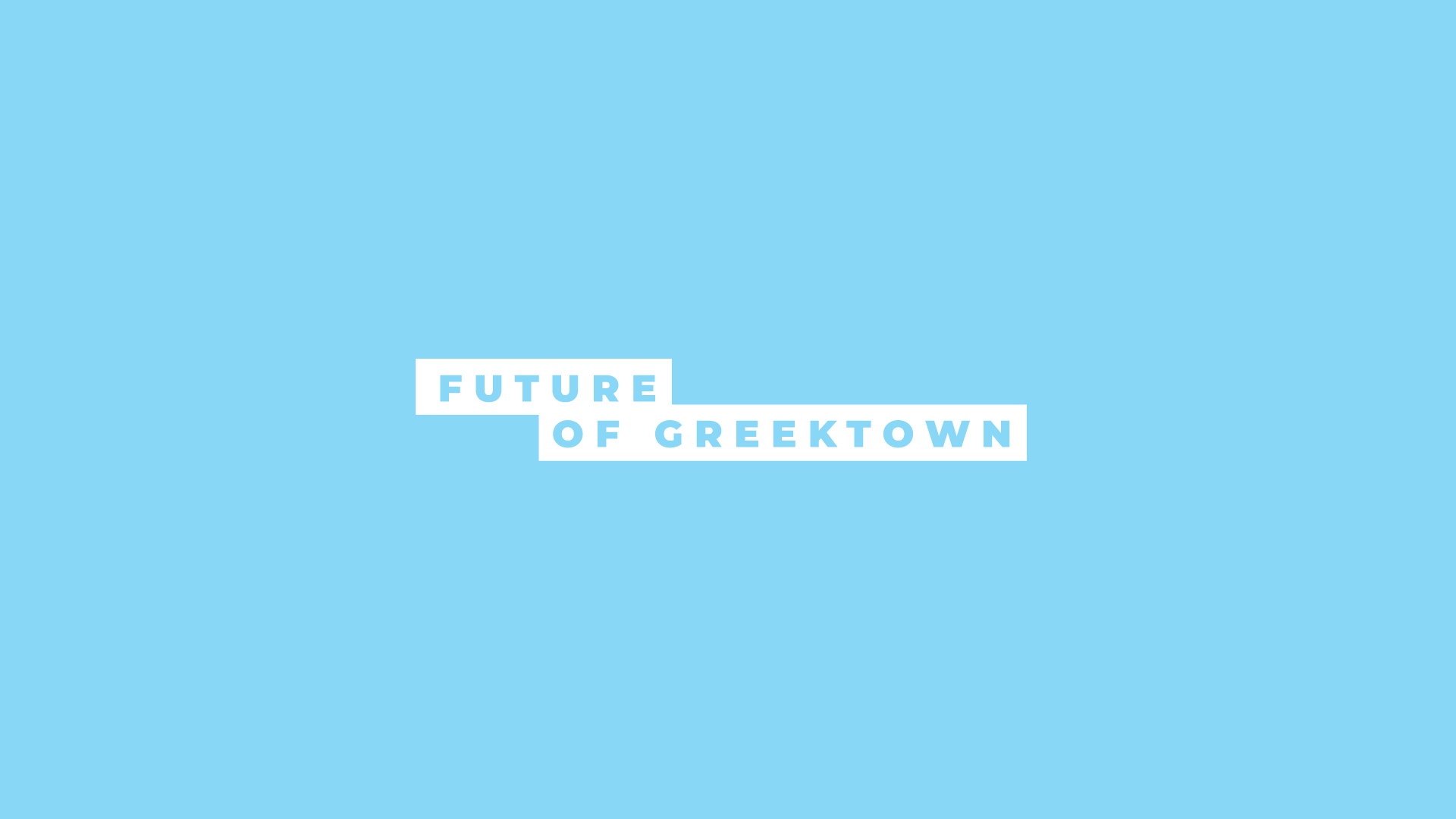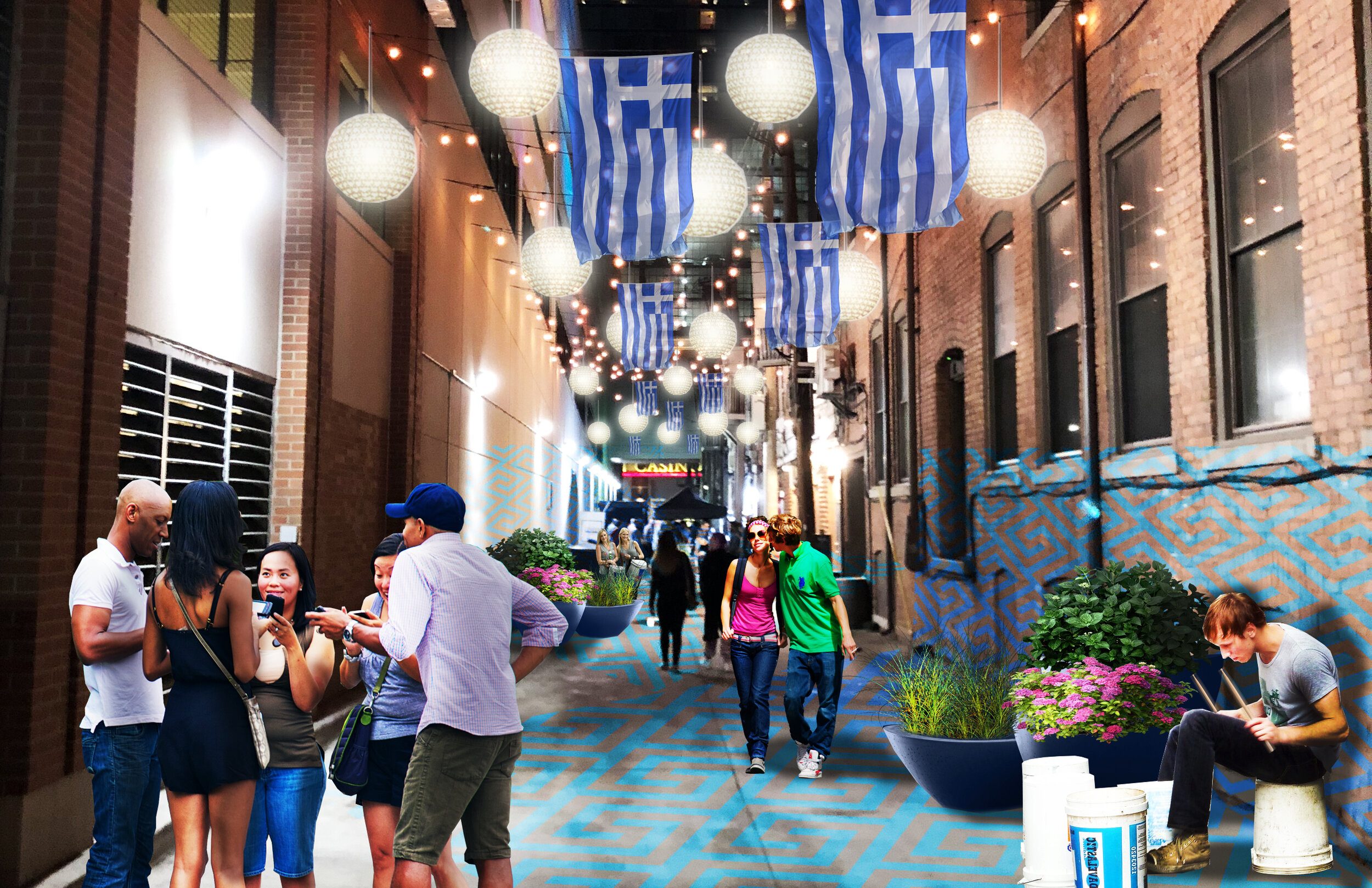The Greektown Neighborhood Partnership advances the equitable development of the district through community and economic development programs, all while celebrating our cultural roots.
Greektown Neighborhood Vision Framework
The Greektown Neighborhood Framework Vision is a privately funded and community-led urban planning initiative, created in close coordination with downtown stakeholders. The Greektown Neighborhood Partnership is charged with implementing this strategic vision for the future. The purpose of the Framework Vision is to unite the neighborhood, city leaders and planners, private developers, and other stakeholders behind a common vision for the future of Greektown. The creation and implementation of the Framework Vision, along with the expanded focus of the Greektown Neighborhood Partnership, ensures thoughtful development and transformation in the neighborhood.
Stakeholder outcomes from the planning effort focus on five key categories: Public Realm, Mobility & Parking, Culture & History, Development Opportunities, and Neighborhood Experience. Design strategies are focused around connectivity to surrounding neighborhoods and the downtown core, increasing built density, the introduction of new public open spaces connected by activated pedestrian paths, and the creation of a mixed-use neighborhood, expanding uses beyond entertainment. The Greektown Neighborhood Framework Vision considers all opportunities, from public to private, and provides an inspiring roadmap for the future of the historic neighborhood. As the east gateway to downtown, Greektown will emphasize connected, contextual, and inclusive development. The Framework also amplifies opportunities in conjunction with planned new development in and around the neighborhood.
The Greektown Neighborhood Framework Vision was a collaborative effort created by SOM (Skidmore, Owings and Merrill), widely considered the leaders in urban design and planning. The group also worked in close consultation with HR&A, OJB Landscape Architecture, Sam Schwartz Engineering, McIntosh Poris Associates, and Kraemer Design Group.
Randolph Plaza | Developing a Public Park Space
A new public park plaza is planned for downtown! This new pedestrian plaza will serve as the gateway to historic Greektown!
As imagined in the Framework, the large intersection on Randolph Street between Monroe and Gratiot will transform into a public pedestrian plaza and gateway to Greektown. The Plaza will connect Greektown to the central downtown and complement forthcoming development in the district by creating a pedestrian-friendly setting and supporting existing businesses in the area by driving pedestrian traffic. Elements of the project include universal access, safety, greening, public art, and business and economic development, all while celebrating the district’s strong cultural roots. Fundamental to the design and development is cultural heritage and arts interpretation that engages through an exploration of multiple ethnic narratives.
CLICK HERE to view the final design report for Randolph Plaza.
GNP completed pre-development planning in 2021 for the Plaza at Gratiot and Randolph and successfully fundraised for its construction in 2022. We are due to break ground on the project in fall 2024. Greektown Neighborhood Partnership is proud to collaborate with the Downtown Detroit Partnership, Bedrock, Paradise Valley Conservancy, and Karp & Associates in securing $13,740,000 in funding though the Michigan Economic Development Corporation Revitalization and Placemaking (RAP) Grant Program. This $13.7 million grant will leverage over $50 million for parks and building rehabilitation projects in Downtown Detroit with localized impact. With this funding and matching sources, Greektown Neighborhood Partnership has secured funding to construct the Plaza as the gateway to Greektown. Special thanks to the Michigan Economic Development Corporation, Downtown Development Authority, City of Detroit Department of Public Works, and Gilbert Family Foundation for supporting the construction of Randolph Plaza.
MONROE STREETSCAPE redesign project
Greektown Neighborhood Partnership has completed pre-development planning and is currently in construction document phase for a complete redesign of Monroe Street, one of Detroit’s most special places. It has maintained its status as a primary commercial street for the area for over a century and continues to attract a broad array of locals and international visitors to its entertainment venues and eateries. Its intimate scale, Victorian architecture, and downtown location have made it one of the City’s most walkable commercial corridors. The purpose of the Monroe Street Streetscape Redesign project is to re-imagine Monroe Street as one that prioritizes pedestrians, provides program flexibility, increases safety, and celebrates the rich cultural and historic heritage of Greektown. The project is an opportunity to create an innovative streetscape in the City of Detroit with the ability to completely pedestrianize Monroe Street. The project was identified as a main goal of the Greektown Neighborhood Framework Vision. The streetscape improvements of Monroe Street are essential in establishing a broad palette of experiences through the main corridor and heart of Greektown. The future of Monroe Street accommodates users of all kinds and modes and must be refocused to prioritize the thousands of pedestrians that walk it each day, supporting and complementing the many businesses along it. Culture and art opportunities will be defined through a robust community engagement strategy.
Pre-development planning was completed by SmithGroup through the generous support of the Hollywood Casino at Greektown, Bedrock, the Papas Family, Community Foundation for Southeast Michigan, and the Teftsis Family. Greektown Neighborhood Partnership engaged with the community over the course of the year though online surveys, public meetings, days of walkshops, open houses during the Greektown Heritage Festival, and countless refinement with the community and governmental agencies.
The Greektown Neighborhood Partnership has been awarded $20 million from the State of Michigan to complete this reimagined Greektown corridor. We are currently in construction document phase and have engaged SmithGroup for design and engineering and Colasanti Construction Services for our construction management teams. We are aiming to break ground in spring 2025. This transformational project will serve as a draw for visitors and support critical event programming, ensuring the continued viability of the district’s businesses and vibrant community.
CLICK HERE to view the MONROE STREETSCAPE REDESIGN PACKAGE
Many improvements to enhance the Monroe Street experience include strategies for:
Wide pedestrian-only zones for meandering
Human-scaled and plentiful vegetation
High density and diversity of lighting
Signature district/street signage
Premium paving
Street furniture and ample seating
Dedicated and expanded spaces for private business outdoor patios
Dedicated spaces for events/markets/festivals
De-emphasized separation between street and sidewalk
Emphasized separation between sidewalk and surface parking lots
Dedicated areas for drop-offs/pick-ups
Multi-modal transit integration and prioritization
Culture, heritage, and art opportunities integration
Greektown Neighborhood Partnership is coordinating the project with the City of Detroit Department of Public Works and Planning and Development Departments, and Michigan Department of Transportation, engaging with Greektown business and property owners, and major community stakeholders and organizations.
Second Baptist Church of Detroit | Rehabilitation and Nomination Project
Greektown Neighborhood Partnership was awarded the National Park Service African American Civil Rights Program Grant for Second Baptist Church of Detroit. The grant of $425,959 will support capital improvements to Second Baptist Church of Detroit and an update to the National Register of Historic Places Nomination. Second Baptist Church is the oldest African American congregation in the State of Michigan and played a pivotal role in the African American Civil Rights Movement in both the nineteenth and twentieth centuries. Established in 1836 as the Society of Second Baptist, it played an important role in the Underground Railroad and the abolitionist movement in the 1800s, with the most fervent abolitionist activists associated with and meeting at Second Baptist Church. In the 1900s Second Baptist continued to lead the African American community in the struggle for equality, addressing social welfare, employment, segregation, and racism.
Capital improvements to Second Baptist Church of Detroit will include roof restoration, repair, and replacement. The National Register of Historic Places Nomination for Second Baptist Church of Detroit dated March 19, 1975, will also be updated to include a comprehensive history and documentation highlighting its role in the Civil Rights Movement and the inclusion of the 1968 modern addition by notable Black architect Nathan Johnson in the Brutalist style.
One of 53 projects funded nationwide, and one of five in Michigan, the African American Civil Rights Program is funded by the Historic Preservation Fund administered through the National Park Service, Department of the Interior.











